Aftermath of World War II
| World War II |
|---|
| Navigation |
|
|
| Timelines of World War II |
|---|
| Chronological |
| Prelude |
| By topic |
| By theatre |
Theaftermath of World War IIsaw the rise of two globalsuperpowers,theSoviet Union(USSR) and theUnited States(US). The aftermath ofWorld War IIwas also defined by the rising threat ofnuclear warfare,the creation and implementation of theUnited Nationsas anintergovernmental organization,and thedecolonizationofAsia,Oceania,South AmericaandAfricabyEuropeanandEast Asianpowers, most notably by theUnited Kingdom,France,andJapan.
Once allies during World War II, the United States and the Soviet Union became competitors on the world stage and engaged in theCold War,so called because it never resulted in overt, declared total war between the two powers. It was instead characterized byespionage,political subversionandproxy wars.Western Europeand Asia were rebuilt through the AmericanMarshall Plan,whereasCentral and Eastern Europefell under theSoviet sphere of influenceand eventually behind an "Iron Curtain".Europe was divided into a US-ledWestern Blocand a USSR-ledEastern Bloc.Internationally, alliances with the two blocs gradually shifted, with some nations trying to stay out of the Cold War through theNon-Aligned Movement.The war also saw anuclear arms racebetween the two superpowers; part of the reason that the Cold War never became a "hot" war was that the Soviet Union and the United States had nuclear deterrents against each other, leading to amutually assured destructionstandoff.
As a consequence of the war, the Allies created theUnited Nations,an organization for international cooperation and diplomacy, similar to theLeague of Nations.Members of the United Nations agreed to outlawwars of aggressionin an attempt to avoid athird world war.The devastated great powers of Western Europe formed theEuropean Coal and Steel Community,which later evolved into theEuropean Economic Communityand ultimately into the currentEuropean Union.This effort primarily began as an attempt to avoid another war betweenGermanyandFranceby economic cooperation and integration, and a common market for important natural resources.
The end of the war opened the way for decolonization from the great powers. Independence was granted toIndiaandPakistan(from the United Kingdom),Indonesia(from theNetherlands), thePhilippines(from the US) and a number ofArab nations,from specific mandates which had been granted to great powers fromLeague of Nations Mandatesand in addition to the establishment ofIsrael(from the United Kingdom). Independence for the nations ofSub-Saharan Africacame in the 1960s.
The aftermath of World War II saw the rise of communist influence in East Asia, with thePeople's Republic of China,as theChinese Communist Partyemergedvictoriousfrom theChinese Civil Warin 1949.
Immediate effects of World War II[edit]

At the end of the war, millions of people were dead and millions more homeless, the European economies had collapsed, and much of Europe's industrial infrastructure had been destroyed. The German people as a whole, but its youth in particular, ended up being deeply scorched psychologically by the ordeal which they went through during the previous decade, from the time when theNazistook power promising them a thousand years of world dominance, until their major cities were destroyed, turned to rubble by theAlliedbombardments.[1]The trauma caused to them was multifaceted as it permeated all levels of society, by means of the systematicNazificationof the country with the strategic creation of theReich Ministry of Public Enlightenment and Propagandawhich tookover the media and all institutions, and put in place the systematicindoctrination of the very youngvia the creation of theHitler Youth,theDeutsches Jungvolk,theLeague of German Girlsand theJungmädelbund.Then by the end of the war, once their major cities were devastated, ensued a widespread famine, which was followed by the wave ofdenazificationwhich swept throughout their humiliated country, ending with the pervasive shame of their parents who believed in the illusive promises of their defeatedFührer.
TheSoviet Union,too, had been heavily affected. In response, in 1947,U.S. Secretary of StateGeorge Marshalldevised the "European Recovery Program", which became known as theMarshall Plan.Under the plan, during 1948–1952 theUnited States governmentallocated US$13 billion (US$177 billion in 2023 dollars) for the reconstruction of the affected countries ofWestern Europe.
United Kingdom[edit]
By the end of the war, the economy of theUnited Kingdomwas one of severe privation. More than a quarter of its national wealth had been consumed. Until the introduction in 1941 ofLend-Leaseaid from the US, the UK had been spending its assets to purchase American equipment including aircraft and ships—over £437 million on aircraft alone. Lend-Lease came just before its reserves were exhausted. Britain had placed 55% of its total labour force into war production.
In spring 1945, theLabour Partywithdrew from the wartime coalition government, in an effort to oustWinston Churchill,forcing ageneral election.Following a landslide victory, Labour held more than 60% of the seats in theHouse of Commonsand formed a new government on 26 July 1945 underClement Attlee.
Britain's war debt was described by some in the American administration as a "millstone round the neck of the British economy". Although there were suggestions for an international conference to tackle the issue, in August 1945 the U.S. announced unexpectedly that the Lend-Lease programme was to end immediately.
The abrupt withdrawal of American Lend-Lease support to Britain on 2 September 1945 dealt a severe blow to the plans of the new government. It was only with the completion of theAnglo-American loanby the United States to Great Britain on 15 July 1946 that some measure of economic stability was restored. However, the loan was made primarily to support British overseas expenditure in the immediate post-war years and not to implement the Labour government's policies for domestic welfare reforms and thenationalisationof key industries. Although the loan was agreed on reasonable terms, its conditions included what proved to be damaging fiscal conditions forsterling.From 1946 to 1948, the UK introduced bread rationing, which it had never done during the war.[2][3][4][5]
Soviet Union[edit]

The Soviet Union suffered enormous losses in the war against Germany. The Soviet populationdecreased by about 27 millionduring the war; of these, 8.7 million were combat deaths. The 19 million non-combat deaths had a variety of causes: starvation in thesiege of Leningrad;conditions in German prisons and concentration camps; mass shootings of civilians; harsh labour in German industry; famine and disease; conditions in Soviet camps; and service in German or German-controlled military units fighting the Soviet Union.[6]The population would not return to its pre-war level for 30 years.[7]
Soviet ex-POWsand civilians repatriated from abroad were suspected of having been Nazi collaborators, and 226,127 of them were sent to forced labour camps after scrutiny by Soviet intelligence,NKVD.Many ex-POWs and young civilians were also conscripted to serve in the Red Army. Others worked in labour battalions to rebuild infrastructure destroyed during the war.[8][9]

The economy had been devastated. Roughly a quarter of the Soviet Union's capital resources were destroyed, and industrial and agricultural output in 1945 fell far short of pre-war levels. To help rebuild the country, the Soviet government obtained limited credits from Britain and Sweden; it refused assistance offered by the United States under the Marshall Plan. Instead, the Soviet Union coerced Soviet-occupied Central and Eastern Europe to supply machinery and raw materials. Germany and former Nazi satellites made reparations to the Soviet Union. The reconstruction programme emphasised heavy industry to the detriment of agriculture and consumer goods. By 1953, steel production was twice its 1940 level, but the production of many consumer goods and foodstuffs was lower than it had been in the late 1920s.[10]
The immediate post-war period in Europe was dominated by the Soviet Unionannexing,or converting intoSoviet Socialist Republics,[11][12][13]all the countries invaded and annexed by theRed Armydriving the Germans out of central and eastern Europe. Newsatellite stateswere set up by the Soviets inPoland,Bulgaria,Hungary,[14][page needed]Czechoslovakia,[15]Romania,[16][17]Albania,[18]andEast Germany;the last of these was created from theSoviet zone of occupationin Germany.[19]Yugoslaviaemerged as an independent Communist state allied but not aligned with the Soviet Union, owing to the independent nature of the military victory of thePartisansofJosip Broz TitoduringWorld War II in Yugoslavia.The Allies established theFar Eastern Commissionand Allied Council forJapanto administer their occupation of that country while the establishmentAllied Control Council,administered occupied Germany. In accordance with thePotsdam Conferenceagreements, the Soviet Union occupied and subsequently annexed the strategic island ofSakhalin.
Germany[edit]
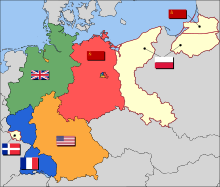
In the east, theSudetenlandreverted to Czechoslovakia following theEuropean Advisory Commission's decision to delimit German territory to be the territory it held on 31 December 1937. Close to one-quarter of pre-war (1937)Nazi Germanywasde factoannexed by the Allies; roughly 10 million Germans were either expelled from this territory or not permitted to return to it if they had fled during the war. The remainder of Germany was partitioned into four zones of occupation, coordinated by theAllied Control Council.TheSaarwas detached and put in economic union with France in 1947. In 1949, theFederal Republic of Germanywas created out of the Western zones. The Soviet zone became theGerman Democratic Republic.
Germany paidreparationsto the United Kingdom, France, and the Soviet Union, mainly in the form ofdismantled factories,forced labour,and coal. The Germanstandard of livingwas to be reduced to its 1932 level.[20]Beginning immediately after the German surrender and continuing for the next two years, the US and Britain pursued an "intellectual reparations" programme to harvest all technological and scientific know-how as well as all patents in Germany. The value of these amounted to around US$10 billion[21](US$156 billion in 2023 dollars). In accordance with theParis Peace Treaties, 1947,reparations were also assessed from the countries ofItaly,Romania,Hungary,Bulgaria,andFinland.
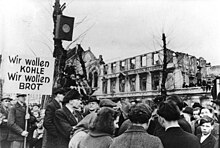
US policy in post-war Germany from April 1945 until July 1947 had been that no help should be given to the Germans in rebuilding their nation, save for the minimum required to mitigate starvation. The Allies' immediate post-war "industrial disarmament" plan for Germany had been to destroy Germany's capability to wage war by complete or partial de-industrialization. The first industrial plan for Germany, signed in 1946, required the destruction of 1,500 manufacturing plants to lower German heavy industry output to roughly 50% of its 1938 level. Dismantling of West German industry ended in 1951. By 1950, equipment had been removed from 706manufacturing plants,and steel production capacity had been reduced by 6.7 million tons.[22]After lobbying by theJoint Chiefs of Staffand GeneralsLucius D. ClayandGeorge Marshall,theTruman administrationaccepted that economic recovery in Europe could not go forward without thereconstruction of the German industrial baseon which it had previously been dependent.[23]In July 1947, President Truman rescinded on "national security grounds"[24]the directive that had ordered the US occupation forces to "take no steps looking toward the economic rehabilitation of Germany." A new directive recognised that "[a]n orderly, prosperous Europe requires the economic contributions of a stable and productive Germany."[25]From mid-1946 onwards Germany received US government aid through theGARIOAprogramme. From 1948 onwards West Germany also became a minor beneficiary of the Marshall Plan. Volunteer organisations had initially been forbidden to send food, but in early 1946 theCouncil of Relief Agencies Licensed to Operate in Germanywas founded. The prohibition against sendingCARE Packagesto individuals in Germany was rescinded on 5 June 1946.
Following the German surrender, theInternational Red Crosswas prohibited from providing aid such as food or visiting POW camps for Germans inside Germany. However, after making approaches to the Allies in the autumn of 1945 it was allowed to investigate the camps in the UK and French occupation zones of Germany, as well as to provide relief to the prisoners held there. On 4 February 1946, the Red Cross was also permitted to visit and assist prisoners in the U.S. occupation zone of Germany, although only with very small quantities of food. The Red Cross petitioned successfully for improvements to be made in the living conditions of German POWs.[26]
France[edit]
AsFrance was liberatedfrom German occupation, anépuration(purge) of real and suspected Nazi collaborators began. At first this was undertaken in an extralegal manner by the French Resistance (called theépuration sauvage,"wild purge" ). French women who had had romantic liaisons with German soldiers were publicly humiliated and had their heads shaved. There were also a wave of summary executions estimated to have killed about 10,000 people.
When theProvisional Government of the French Republicestablished control, theÉpuration légale( "legal purge" ) began. There were no international war crimes trials for French collaborators, who were tried in the domestic courts. Approximately 300,000 cases were investigated; 120,000 people were given various sentences including 6,763 death sentences (of which only 791 were carried out). Most convicts were given amnesty a few years later.
Italy[edit]

The aftermath of World War II left Italy with an anger against the monarchy for its endorsement of theFascist regimefor the previous twenty years. These frustrations contributed to a revival of the Italian republican movement.[27]In the1946 Italian constitutional referendum,held on 2 June, a day celebrated since asFesta della Repubblica,theItalian monarchywas abolished, having been associated with the deprivations of the war and the Fascist rule, especially in theNorth,and Italy became a republic. This was the first time that Italian women voted at the national level, and the second time overall considering the local elections that were held a few months earlier in some cities.[28][29]
KingVictor Emmanuel III's son, KingUmberto II,was forced to abdicate and exiled. TheRepublican Constitutionwas approved on 1 January 1948, resulting from the work of aConstituent Assemblyformed by the representatives of all theanti-fascistforces that contributed to the defeat of Nazi and Fascist forces during theliberation of Italy.[30]Unlike in Germany and Japan, nowar crimes tribunalswere held against Italian military and political leaders, though theItalian resistancesummarily executedsome of them (such asMussolini) at the end of the war; theTogliatti amnesty,taking its name from the Communist Party secretary at the time, pardoned all wartime common and political crimes in 1946.
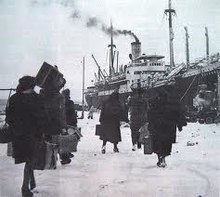
The 1947,Treaty of Peace with Italyspelled the end of theItalian colonial empire,along with other border revisions, like the transfer of theItalian Islands of the Aegeanto theKingdom of Greeceand the transfer toFranceofBrigaandTenda,as well than to minor revisions of the Franco-Italian border. Moreover, under the Treaty of Peace with Italy,Istria,Kvarner,most of theJulian Marchas well as theDalmatiancity ofZarawas annexed byYugoslaviacausing theIstrian–Dalmatian exodus,which led to the emigration of between 230,000 and 350,000 of local ethnicItalians(Istrian ItaliansandDalmatian Italians), the others being ethnic Slovenians, ethnic Croatians, and ethnicIstro-Romanians,choosing to maintain Italian citizenship,[31]towards Italy, and in smaller numbers, towards theAmericas,AustraliaandSouth Africa.[32][33]
The 1947 Treaty of Peace compelled Italy to pay $360 million (US dollars at 1938 prices) inwar reparations:$125 million to Yugoslavia, $105 million toGreece,$100 million to theSoviet Union,$25 million toEthiopiaand $5 million toAlbania.In 1954 theFree Territory of Trieste,an independent territory between northern Italy and Yugoslavia underdirect responsibilityof theUnited Nations Security Council,was divided between the two states, Italy and Yugoslavia. The Italian border that applies today has existed since 1975, whenTriestewas formally re-annexed to Italy after theTreaty of Osimo.In 1950,Italian Somalilandwas made aUnited Nations Trust Territoryunder Italian administration until 1 July 1960.
Austria[edit]
TheFederal State of Austriahad been annexed by Germany in 1938 (Anschluss,this union was banned by theTreaty of Versailles). Austria (calledOstmarkby the Germans) was separated from Germany and divided into four zones of occupation. With theAustrian State Treaty,these zones reunited in 1955 to become theRepublic of Austria.
Japan[edit]
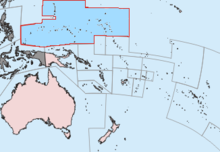
Following the war, the Allies rescindedJapanese Empirepre-war annexations such asManchuria,andKoreabecame militarily occupied by the United States in thesouthand by the Soviet Union in thenorth.The Philippines andGuamwere returned to the United States. Burma, Malaya, and Singapore were returned to Britain and Indochina back to France. The Dutch East Indies was to be handed back to the Dutch but was resisted leading to the Indonesian war for independence. At theYalta Conference,US PresidentFranklin D. Roosevelthad secretly traded the Japanese Kurils and south Sakhalin to the Soviet Union in return for Soviet entry in the war with Japan.[34]The Soviet Union annexed theKuril Islands,provoking theKuril Islands dispute,which is ongoing, as Russia continues to occupy the islands.
Hundreds of thousands of Japanese were forced to relocate to the Japanese main islands. Okinawa became a main US staging point. The US covered large areas of it with military bases and continued to occupy it until 1972, years after the end of the occupation of the main islands. The bases still remain. To skirt theGeneva Convention,the Allies classified many Japanese soldiers asJapanese Surrendered Personnel(JSP) instead of POWs and used them as forced labour until 1947. The UK, France, and the Netherlands used JSP to support their military operations in the region after World War II. GeneralDouglas MacArthurestablished theInternational Military Tribunal for the Far East.The Allies collected reparations from Japan.
To further remove Japan as a potential future military threat, theFar Eastern Commissiondecided to de-industrialise Japan, with the goal of reducing Japanese standard of living to what prevailed between 1930 and 1934.[35][36]In the end, the de-industrialisation programme in Japan was implemented to a lesser degree than the one in Germany.[35]Japan received emergency aid fromGARIOA,as did Germany. In early 1946, the Licensed Agencies for Relief in Asia were formed and permitted to supply Japanese with food and clothes. In April 1948 the Johnston Committee Report recommended that the economy of Japan should be reconstructed due to the high cost to US taxpayers of continuous emergency aid.
Survivors of theatomic bombings of Hiroshima and Nagasaki,known ashibakusha( bị bạo giả ), were ostracized by Japanese society. Japan provided no special assistance to these people until 1952.[37]By the 65th anniversary of the bombings, total casualties from the initial attack and later deaths reached about 270,000 in Hiroshima[38]and 150,000 in Nagasaki.[39]About 230,000 hibakusha were still alive as of 2010[update],[38]and about 2,200 were suffering from radiation-caused illnesses as of 2007[update].[40]
Finland[edit]
In theWinter Warof 1939–1940, the Soviet Union invaded neutralFinlandand annexed some of its territory.From 1941 until 1944,Finland aligned itself with Nazi Germany in a failed effort to regain lost territories from the Soviets. Finland retained its independence following the war but remained subject toSoviet-imposed constraintsin its domestic affairs.
The Baltic states[edit]
In 1940 the Soviet Union invaded and annexed the neutralBaltic states,Estonia,Latvia,andLithuania.In June 1941, the Soviet governments of the Baltic states carried outmass deportationsof "enemies of the people"; as a result, many treated the invading Nazis as liberators when they invaded only a week later. TheAtlantic Charterpromised self-determination to people deprived of it during the war. TheBritish Prime Minister,Winston Churchill,argued for a weaker interpretation of the Charter to permit the Soviet Union to continue to control the Baltic states.[41]In March 1944 the U.S. accepted Churchill's view that the Atlantic Charter did not apply to the Baltic states.[41]With the return of Soviet troops at the end of the war, theForest Brothersmounted aguerrilla war.This continued until the mid-1950s.
The Philippines[edit]
An estimated one million military and civilian Filipinos were killed from all causes; of these 131,028 were listed as killed in seventy-twowar crimeevents. According to a United States analysis released years after the war, U.S. casualties were 10,380 dead and 36,550 wounded; Japanese dead were 255,795.[42]
Population displacement[edit]

As a result of the new borders drawn by the victorious nations, large populations suddenly found themselves in hostile territory. The Soviet Union took over areas formerly controlled by Germany, Finland, Poland, and Japan. Poland lost theKresyregion (about half of its pre-War territory) and receivedmost of Germany eastof theOder–Neisse line,including the industrial regions ofSilesia.The German state of the Saar was temporarily a protectorate of France but later returned to German administration. As set forth at Potsdam, approximately 12 million people were expelled from Germany, including seven million from Germany proper, and three million from theSudetenland.
During the war, the United States government interned approximately 110,000Japanese AmericansandJapanesewho lived along the Pacific coast of the United States in the wake ofImperial Japan'sattack on Pearl Harbor.[43][44]Canada internedapproximately 22,000 Japanese Canadians, 14,000 of whom were born in Canada. After the war, some internees chose to return to Japan, while most remained in North America.
Poland[edit]
The Soviet Union expelled at least 2 million Poles from the east of the new border approximating theCurzon Line.This estimate is uncertain as neither the Polish Communist government or the Soviet government kept track of the number of expelled people. The number of Polish citizens inhabiting Polish borderlands (Kresyregion) was about 13 million beforeWorld War IIbroke out according to official Polish statistics. Polish citizens killed in the war that originated from the Polish borderlands territory (killed by either the German Nazi regime or the Soviet regime, or expelled to distant parts ofSiberia) were accounted as Russian, Ukrainian or Belarusian casualties of war in official Soviet historiography. This fact imposes additional difficulties in making the correct estimation of the number of Polish citizens forcibly transferred after the war.[45]The border change also reversed the results of the 1919–1920Polish–Soviet War.Former Polish cities such asLwówcame under control of theUkrainian Soviet Socialist Republic.Additionally, the Soviet Union transferred more than two million people within their own borders; these included Germans, Finns,Crimean Tatars,andChechens.
Rape during occupation[edit]
In Europe[edit]
As Soviet troops marched across the Balkans, they committed rapes and robberies inRomania,Hungary,Czechoslovakiaand Yugoslavia.[46]The population of Bulgaria was largely spared of this treatment, possibly due to a sense of ethnic kinship or to the leadership of MarshalFyodor Tolbukhin.[46]The population of Germany was treated significantly worse.[47]Rape and murder of German civilians was as bad as, and sometimes worse than, Nazi propaganda had anticipated.[48][49]Political officers encouraged Soviet troops to seek revenge and terrorise the German population.[50]On "the basis ofHochrechnungen(projections or estimations) "," 1.9 million German women altogether were raped at the end of the war by Red Army soldiers. "[51][52][53]About one-third of all German women in Berlin were raped by Soviet forces.[51]A substantial minority was raped multiple times.[53][54]In Berlin, contemporary hospital records indicate between 95,000 and 130,000 women were raped by Soviet troops.[53]About 10,000 of these women died, mostly by suicide.[51][53]Over 4.5 million Germans fled towards the West.[55]The Soviets initially had no rules against their troops "fraternising" with German women, but by 1947 they started to isolate their troops from the German population in an attempt to stop rape and robbery by the troops.[56]Not all Soviet soldiers participated in these activities.[57]
Foreign reports of Soviet brutality were denounced[by whom?]as false.[58]Rape, robbery, and murder were blamed on German bandits impersonating Soviet soldiers.[59]Some justified Soviet brutality towards German civilians based on previous brutality of German troops toward Russian civilians.[60]Until the reunification of Germany, East German histories virtually ignored the actions of Soviet troops, and Russian histories still tend to do so.[61]Reports of mass rapes by Soviet troops were often dismissed as anti-Communist propaganda or the normal byproduct of war.[51]
Rapes also occurred under other Allied forces in Europe, though the majority were committed by Soviet troops.[54]In a letter to the editor ofTimepublished in September 1945, aUnited States Armysergeantwrote, "Our own Army and the British Army along with ours have done their share of looting and raping... This offensive attitude among our troops is not at all general, but the percentage is large enough to have given our Army a pretty black name, and we too are considered an army of rapists."[62]Robert Lilly's analysis of military records led him to conclude about 14,000 rapes occurred in Britain, France, and Germany at the hands of US soldiers between 1942 and 1945.[63]Lilly assumed that only 5% of rapes by American soldiers were reported, making 17,000 GI rapes a possibility, while analysts estimate that 50% of (ordinary peacetime) rapes are reported.[64]Supporting Lilly's lower figure is the "crucial difference" that for World War II military rapes "it was the commanding officer, not the victim, who brought charges".[64]According to German historianMiriam Gebhardt,as many as 190,000 women were raped by U.S. soldiers in Germany.[65]
German soldiers left manywar childrenbehind in nations such as France and Denmark, which were occupied for an extended period. After the war, the children and their mothers often suffered recriminations. In Norway, the "Tyskerunger" (German-kids) suffered greatly.[66][67]
During the Italian campaign, theGoumiers,French Moroccan colonial troops attached to the French Expeditionary Forces, have been accused of committing rape and murder against the Italian peasant communities, mostly targeting civilian women and girls, as well as a few men and boys.[68][unreliable source?]In Italy the victims of these acts were described asMarocchinatemeaning literally "Moroccaned" (or people who have been subjected to acts committed by Moroccans). According to Italian victims associations, a total of more than 7,000 civilians, including children, were raped by Goumiers.[69]
In Japan[edit]
In the first few weeks of the American military occupation of Japan, rape and other violent crime was widespread in naval ports like Yokohama and Yokosuka but declined shortly afterward. There were 1,336 reported rapes during the first 10 days of the occupation of Kanagawa prefecture.[70]Historian Toshiyuki Tanaka relates that in Yokohama, the capital of the prefecture, there were 119 known rapes in September 1945.[71][page needed]
Historians Eiji Takemae and Robert Ricketts state that "When US paratroopers landed in Sapporo, an orgy of looting, sexual violence, and drunken brawling ensued. Gang rapes and other sex atrocities were not infrequent" and some of the rape victims committed suicide.[72]
General Robert L. Eichelberger,the commander of the U.S. Eighth Army, recorded that in the one instance when the Japanese formed a self-help vigilante guard to protect women from off-duty GIs, the Eighth Army ordered armoured vehicles in battle array into the streets and arrested the leaders, and the leaders received long prison terms.[72][73]
According to Takemae and Ricketts, members of theBritish Commonwealth Occupation Force(BCOF) were also involved in rapes:
A former prostitute recalled that as soon as Australian troops arrived in Kure in early 1946, they "dragged young women into their jeeps, took them to the mountain, and then raped them. I heard them screaming for help nearly every night". Such behavior was commonplace, but news of criminal activity by Occupation forces was quickly suppressed.[72]
Rape committed by U.S. soldiers occupying Okinawa was also a notable phenomenon. Okinawan historian Oshiro Masayasu (former director of the Okinawa Prefectural Historical Archives) writes:
Soon after the U.S. marines landed, all the women of a village onMotobu Peninsulafell into the hands of American soldiers. At the time, there were only women, children and old people in the village, as all the young men had been mobilized for the war. Soon after landing, the marines "mopped up" the entire village, but found no signs of Japanese forces. Taking advantage of the situation, they started "hunting for women" in broad daylight and those who were hiding in the village or nearby air raid shelters were dragged out one after another.[74]
According to Toshiyuki Tanaka, 76 cases of rape or rape-murder were reported during the first five years of the American occupation of Okinawa. However, he claims this is probably not the true figure, as most cases were unreported.[75]
Comfort women[edit]
During World War II the Japanese military established brothels filled with "comfort women",a euphemism for the 200,000 girls and women who were forced intosexual slaveryfor Japanese soldiers.[76][77]In Confucian nations like Korea and China, where premarital sex is considered shameful, the subject of the "comfort women" was ignored for decades after 1945 as the victims were considered pariahs.[78]Dutchcomfort women brought a successful case before the Batavia Military Tribunal in 1948.[79]
Post-war tensions[edit]
Europe[edit]
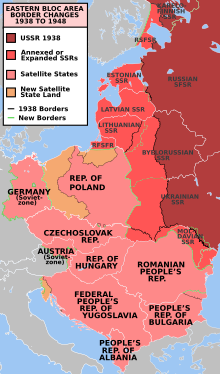
The alliance between the Western Allies and the Soviet Union began to deteriorate even before the war was over,[80]whenStalin,Roosevelt, and Churchill exchanged a heated correspondence over whether thePolish government-in-exile,backed by Roosevelt and Churchill, or theProvisional Government,backed by Stalin, should be recognised. Stalin won.[81]
A number of allied leaders felt that war between the United States and the Soviet Union was likely. On 19 May 1945, American Under-Secretary of StateJoseph Grewwent so far as to say that it was inevitable.[82][83]
On 5 March 1946, in his"Sinews of Peace" (Iron Curtain)speech atWestminster CollegeinFulton, Missouri,Winston Churchillsaid "a shadow" had fallen over Europe. He described Stalin as having dropped an "Iron Curtain"between East and West. Stalin responded by charging that co-existence between communist countries and the West was impossible.[84]In mid-1948 the Soviet Unionimposed a blockade on the Western zone of occupation in Berlin.
Due to the rising tension in Europe and concerns over further Soviet expansion, American planners came up with a contingency plan code-namedOperation Dropshotin 1949. It considered possible nuclear and conventional war with the Soviet Union and its allies in order to counter a Soviet takeover of Western Europe, the Near East and parts of Eastern Asia that they anticipated would begin around 1957. In response, the US would saturate the Soviet Union with atomic and high-explosive bombs, and then invade and occupy the country.[85]In later years, to reduce military expenditures while countering Soviet conventional strength, PresidentDwight Eisenhowerwould adopt a strategy ofmassive retaliation,relying on the threat of a US nuclear strike to prevent non-nuclear incursions by the Soviet Union in Europe and elsewhere. The approach entailed a major buildup of US nuclear forces and a corresponding reduction in America's non-nuclear ground and naval strength.[86][87]The Soviet Union viewed these developments as "atomic blackmail".[88]

InGreece,civil war broke outin 1946 between Anglo-American-supported royalist forces andcommunist-led forces,with the royalist forces emerging as the victors.[89]The US launched a massive programme of military and economic aid to Greece and to neighbouringTurkey,arising from a fear that the Soviet Union stood on the verge of breaking through the NATO defence line to the oil-richMiddle East.On 12 March 1947, to gainCongressionalsupport for the aid, President Truman described the aid as promotingdemocracyin defence of the "Free World",a principle that became known as theTruman Doctrine.[90]
The US sought to promote an economically strong and politically united Western Europe to counter the threat posed by the Soviet Union. This was done openly using tools such as theEuropean Recovery Program,which encouraged European economic integration. TheInternational Authority for the Ruhr,designed to keep German industry down and controlled, evolved into theEuropean Coal and Steel Community,a founding pillar of theEuropean Union.The United States also worked covertly to promote European integration, for example using theAmerican Committee on United Europeto funnel funds to European federalist movements. In order to ensure that Western Europe could withstand the Soviet military threat, theWestern European Unionwas founded in 1948 andNATOin 1949. The first NATO Secretary General,Lord Ismay,famously stated the organisation's goal was "to keep the Russians out, the Americans in, and the Germans down". However, without the manpower and industrial output ofWest Germanyno conventional defence of Western Europe had any hope of succeeding. To remedy this, in 1950 the US sought to promote theEuropean Defence Community,which would have included a rearmed West Germany. The attempt was dashed when theFrench Parliamentrejected it. On 9 May 1955, West Germany was instead admitted to NATO; the immediate result was the creation of theWarsaw Pactfive days later.
TheCold Waralso saw the creation of propaganda and espionage organisations such asRadio Free Europe,theInformation Research Department,theGehlen Organization,theCentral Intelligence Agency,theSpecial Activities Division,and theMinistry for State Security,as well as theradicalizationand proliferation of numerousfar-leftandfar-rightterrorist organizationsin Western European countries (Italy,France,West Germany,Belgium,Francoist Spain,and theNetherlands),[91][92][93][94]with spillovers inNorthernandSoutheastern Europe.[94]
Asia[edit]
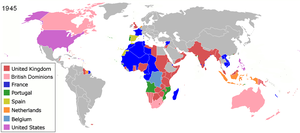
In Asia, the surrender of Japanese forces was complicated by the split between East and West as well as by the movement toward national self-determination in European colonial territories.
India[edit]
Decisions to decolonizeBritish Indialed to an agreement to a partition of the country along religious lines into two independent dominions: India and Pakistan. The partition resulted in communal violence and massive displacements of population. It is often described as the largest mass human migration and one of the largest refugee crises in history.
China[edit]
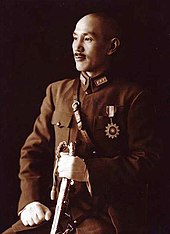
As agreed to at theYalta Conference,the Soviet Union declared war on Japan. Soviet forcesinvaded Manchuriawhich led to the collapse of theManchukuoand expulsion of allJapanese settlers from the puppet state.The Soviet Union dismantled the industrial base in Manchuria that the Japanese had built up and it subsequently became a base for theCommunistChinese forces due to the area being under Soviet occupation.
Following the end of the war, theKuomintang(KMT) party (led by generalissimoChiang Kai-shek) and the Communist Chinese forces resumedfighting each other,which they temporarily suspended in order to fight Japan. The fight against the Japanese occupiers had strengthened popular support among the Chinese people for the Communist forces while it weakened the KMT, which depleted its strength fighting them. Full-scale war between the KMT and CCF broke out in June 1946. Despite U.S. support for the Kuomintang, Communist forces ultimately prevailed and they established thePeople's Republic of China(PRC) on the mainland. The KMT forces retreated to the island ofTaiwanin 1949 where they established the Republic of China (ROC).
With the Communist victory in the civil war, the Soviet Union gave up its claim to military bases in China that were given to it by its Western Allies at the end of World War II.[citation needed]
While large scale hostilities largely ceased by 1950, intermittent clashes occurred between the two from 1950 to 1979. Taiwan unilaterally declared the civil war over in 1991, but no formal peace treaty or truce has been signed and the PRC continues to officially see Taiwan as a breakaway province that rightfully belongs to it.[citation needed]
The outbreak of theKorean Wara few months after the conclusion of the Chinese Civil War and continued US support for the KMT were the main reasons that prevented the PRC from invading Taiwan.[citation needed]
Korea[edit]
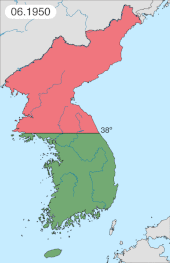
At theYalta Conference,the Allies agreed that an undivided post-war Korea would be placed under four-power multinational trusteeship. After Japan's surrender, this agreement was modified to ajoint Soviet-American occupationof Korea.[95]The agreement was that Korea would be divided and occupied by the Soviets from the north and the Americans from the south.[96]
Korea, formerlyunder Japanese rule,and which had been partially occupied by the Red Army following the Soviet Union's entry into the war against Japan, was divided at the 38th parallel on the orders of theUS War Department.[95][97]A US military government in southern Korea was established in the capital city ofSeoul.[98][99]The American military commander,Lt. Gen.John R. Hodge,enlisted many former Japanese administrative officials to serve in this government.[100]North of the military line, the Soviets administered the disarming and demobilisation of repatriated Korean nationalist guerrillas who had fought on the side of Chinese nationalists against the Japanese in Manchuria during World War II. Simultaneously, the Soviets enabled a build-up of heavy armaments to pro-communist forces in the north.[101]The military line became a political line in 1948, when separate republics emerged on both sides of the 38th parallel, each republic claiming to be the legitimate government of Korea. It culminated in the north invading the south, start of theKorean Wartwo years later.
Malaya[edit]
Labour and civil unrest broke out in theBritish colony of Malayain 1946. A state of emergency was declared by the colonial authorities in 1948 with the outbreak of acts of terrorism. The situation deteriorated into a full-scale anti-colonial insurgency, or Anti-British National Liberation War as the insurgents referred to it, led by theMalayan National Liberation Army(MNLA), the military wing of theMalayan Communist Party.[102]The Malayan Emergency would endure for the next 12 years, ending in 1960. In 1967, communist leaderChin Pengreopened hostilities, culminating in asecond emergencythat lasted until 1989.
French Indochina (Vietnam, Laos, and Cambodia)[edit]
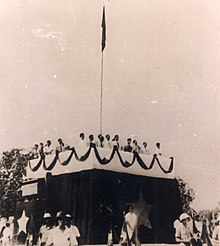
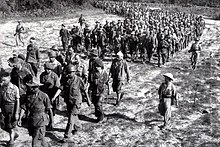
Events during World War II in the colony ofFrench Indochina(consisting of the modern-day states ofVietnam,LaosandCambodia) set the stage for theFirst Indochina Warwhich in turn led to theVietnam War.
During World War II, the Vichy French aligned colonial authorities cooperated with the Japanese invaders. The communist-controlledcommon frontViet Minh(supported by the Allies) was formed among the Vietnamese in the colony in 1941 to fight for the independence of Vietnam, against both the Japanese and prewar French powers. After theVietnamese Famine of 1945support for the Viet Minh was bolstered as the front launched a rebellion, sacking rice warehouses and urging the Vietnamese to refuse to pay taxes. Because the French colonial authorities started to hold secret talks with the Free French, the Japanese interned them 9 March 1945. When Japan surrendered in August, this created a power vacuum, and the Viet Minh took power in theAugust Revolution,declaring the independentDemocratic Republic of Vietnam.However, the Allies (including the Soviet Union) all agreed that the area belonged to the French. Nationalist Chinese forces moved in from the north and British from the south (as the French were unable to do so immediately themselves) and then handed power to the French, a process completed by March 1946. Attempts to integrate the Democratic Republic of Vietnam with French rule failed and the Viet Minh launched their rebellion against the French rule starting the First Indochina War that same year (the Viet Minh organized common fronts to fight the French in Laos and Cambodia).
The warendedin 1954 with French withdrawal and a partition of Vietnam that was intended to be temporary until elections could be held. The Democratic Republic of Vietnam held the north whileSouth Vietnamformed into a separate republic in control ofNgo Dinh Diemwho was backed in his refusal to hold elections by the US. The communist party of the south eventually organized the common frontNLFto fight to unite south and north under the Democratic Republic of Vietnam and thus began theVietnam War,which ended with the Democratic Republic of Vietnamconquering the Southin 1975.
Dutch East Indies (Indonesia)[edit]

JapaninvadedandoccupiedtheDutch East Indiesduring the war and replaced the colonial government with a new administration. Although the top positions were held by Japanese officers, the internment of all Dutch citizens meant that Indonesians filled many leadership and administrative positions. Following the Japanese surrender in August 1945, Indonesian nationalist leaders such asSukarnoandMohammad Hattadeclared Indonesia as independent. A four and a half-year struggle followed as the Dutch tried to re-establish their rule in colony, using a significant portion of their Marshall Plan aid to this end.[103]The Dutch were aided by British forces for the first phase of the conflict until the United Kingdom withdrew. The British also initially used 35,000Japanese Surrendered Personnelto support their military operations in Indonesia. Although Dutch forces re-occupied most of Indonesia, an Indonesianguerrilla campaignsupported by the majority of Indonesians ensured, and ultimately international opinion favoured independence. In December 1949, the Netherlands formally recognised Indonesian sovereignty.[citation needed]
Covert operations and espionage[edit]

British covert operations in the Baltic States, which began in 1944 against the Nazis, escalated following the war. InOperation Jungle,theSecret Intelligence Service(known as MI6) recruited and trained Estonians, Latvians, and Lithuanians for the clandestine work in the Baltic states between 1948 and 1955. Leaders of the operation includedAlfons Rebane,Stasys Žymantas, and Rūdolfs Silarājs. The agents were transported under the cover of the "British Baltic Fishery Protection Service". They launched from British-occupied Germany, using a converted World War IIE-boatcaptained and crewed by former members of thewartime German navy.[105]British intelligence also trained and infiltrated anti-communist agents into Soviet Union from across the Finnish border, with orders to assassinate Soviet officials.[106]In the end, counter-intelligence supplied to theKGBbyKim Philbyallowed the KGB to penetrate and ultimately gain control of MI6's entire intelligence network in the Baltic states.[107]
Vietnamand theMiddle Eastwould later damage the reputation gained by the US during its successes in Europe.[108]
The KGB believed that theThird Worldrather than Europe was the arena in which it could win theCold War.[109]Moscow would in later years fuel an arms buildup inAfrica.In later years, African countries used as proxies in the Cold War would often become "failed states" of their own.[108]
In 2014,The New York Timesreported that "In the decades after World War II, theCentral Intelligence Agency(CIA) and other United States agencies employed at least a thousand Nazis as Cold War spies and informants and, as recently as the 1990s, concealed the government's ties to some still living in America, newly disclosed records and interviews show. "[110]According toTimothy Naftali,"The CIA's central concern [in recruiting former Nazi collaborators] was not so much the extent of the criminal's guilt as the likelihood that the agent's criminal past could remain a secret."[111]: 365
Recruitment of former enemy scientists[edit]
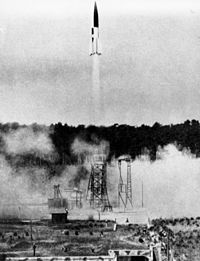
When the divisions of postwar Europe began to emerge, the war crimes programmes and denazification policies of Britain and the United States were relaxed in favour of recruiting German scientists, especially nuclear and long-range rocket scientists.[112]Many of these, prior to their capture, had worked on developing the German V-2 long-range rocket at the Baltic coast German Army Research CenterPeenemünde.Western Allied occupation force officers in Germany were ordered to refuse to cooperate with the Soviets in sharing captured wartime secret weapons,[113]the recovery for which, specifically in regards to advanced German aviation technology and personnel, the British had sent theFedden Missioninto Germany to contact its aviation technology centers and key personnel, paralleled by the United States with its ownOperation Lustyaviation technology personnel and knowledge recovery program.
InOperation Paperclip,beginning in 1945, the United States imported 1,600 German scientists and technicians, as part of the intellectual reparations owed to the US and the UK, including about $10 billion (US$156 billion in 2023 dollars) in patents and industrial processes.[114]In late 1945, three German rocket-scientist groups arrived in the U.S. for duty atFort Bliss, Texas,and atWhite Sands Proving Grounds,New Mexico,as "War Department Special Employees".[115]
The wartime activities of some Operation Paperclip scientists would later be investigated.[116]Arthur Rudolphleft the United States in 1984, in order to not be prosecuted.[117]Similarly, Georg Rickhey, who came to the United States under Operation Paperclip in 1946, was returned to Germany to stand trial at theMittelbau-Dorawar crimes trial in 1947. Following his acquittal, he returned to the United States in 1948 and eventually became a US citizen.[118]
The Soviets beganOperation Osoaviakhimin 1946.NKVDand Soviet army units effectively deported thousands of military-related technical specialists from theSoviet occupation zoneof post-war Germany to the Soviet Union.[119]The Soviets used 92 trains to transport the specialists and their families, an estimated 10,000–15,000 people.[120]Much related equipment was also moved, the aim being to virtually transplant research and production centres, such as the relocatedV-2 rocketcentre atMittelwerkNordhausen,from Germany to the Soviet Union. Among the people moved wereHelmut Gröttrupand about two hundred scientists and technicians fromMittelwerk.[121]Personnel were also taken fromAEG,BMW's Stassfurt jet propulsion group,IG Farben's Leuna chemical works,Junkers,Schott AG,Siebel,Telefunken,andCarl Zeiss AG.[122]
The operation was commanded by NKVD deputyColonel General Serov,[120]outside the control of the localSoviet Military Administration.[123]The major reason for the operation was the Soviet fear of being condemned for noncompliance withAllied Control Councilagreements on the liquidation of German military installations.[124]Some Western observers thought Operation Osoaviakhim was a retaliation for the failure of theSocialist Unity Partyin elections, though Osoaviakhim was clearly planned before that.[125]
Demise of the League of Nations and the founding of the United Nations[edit]
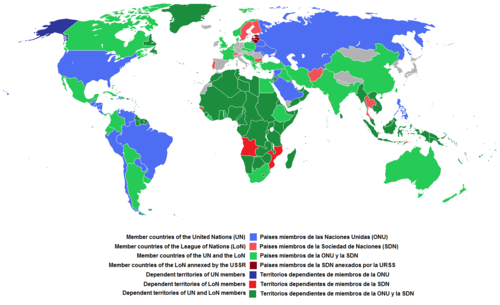
As a general consequence of the war and in an effort to maintain international peace,[126]the Allies formed theUnited Nations(UN), which officially came into existence on 24 October 1945.[127]The UN replaced the defunctLeague of Nations(LN) as an intergovernmental organization. The LN was formally dissolved on 20 April 1946 but had in practice ceased to function in 1939, being unable to stop the outbreak of World War II. The UN inherited some of the bodies of the LN, such as theInternational Labour Organization.
League of Nations mandate,mostly territories that had changed hands inWorld War I,becameUnited Nations trust territories.South West Africa,an exception, was still governed under terms of the original mandate. As the successor body to the League, the UN still assumed a supervisory role over the territory. TheFree City of Danzig,a semi-autonomousCity-statethat was partly overseen by the League, became part ofPoland.
The UN adopted TheUniversal Declaration of Human Rightsin 1948, "as a common standard of achievement for all peoples and all nations." The Soviet Union abstained from voting on adoption of the declaration. The US did notratifythesocial and economic rightssections.[128]
The five major Allied powers were given permanent membership in theUnited Nations Security Council.The permanent members canvetoanyUnited Nations Security Council resolution,the only UN decisions that are binding according tointernational law.The five powers at the time of founding were: the United States of America, the United Kingdom, France, the Soviet Union and theRepublic of China.The Republic of China lost theChinese Civil Warand retreated to the island of Taiwan by 1950 but continued to be a permanent member of the Council even though thede factostate in control of mainland China was thePeople's Republic of China(PRC). This was changed in 1971 when the PRC was given the permanent membership previously held by theRepublic of China.Russia inherited the permanent membership of the Soviet Union in 1991 after the dissolution of that state.
Unresolved conflicts[edit]
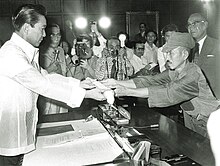
Japanese holdoutspersisted on various islands in thePacific Theatreuntil at least 1974. Although all hostilities are now resolved, a peace treaty has never been signedbetween Japan and Russiadue to theKuril Islands dispute.
Economic aftermath[edit]
By the end of the war, theEuropean economyhad collapsed with some 70% of its industrial infrastructure destroyed.[129]The property damage in the Soviet Union consisted of complete or partial destruction of 1,710 cities and towns, 70,000 villages/hamlets, and 31,850 industrial establishments.[130]The strength of the economic recovery following the war varied throughout the world, though in general, it was quite robust, particularly in the United States.
In Europe,West Germany,after having continued to decline economically during the first years of the Allied occupation, later experienced aremarkable recovery,and had by the end of the 1950s doubled production from its pre-war levels.[131]Italy came out of the war in poor economic condition,[132]but by the 1950s, the Italian economy was marked by stability and high growth.[133]France rebounded quickly and enjoyed rapid economic growth and modernisation under theMonnet Plan.[134]The UK, by contrast, was in a state of economic ruin after the war[135]and continued to experience relative economic decline for decades to follow.[136]
The Soviet Union also experienced a rapid increase in production in the immediate post-war era.[137]Japan experiencedrapideconomic growth, becoming one of the most powerful economies in the world by the 1980s.[138]China, following the conclusion of its civil war, was essentially bankrupt. By 1953, economic restoration seemed fairly successful as production had resumed pre-war levels.[139]This growth rate mostly persisted, though it was interrupted by economic experiments during the disastrousGreat Leap Forward.
At the end of the war, the United States produced roughly half of the world's industrial output. The US, of course, had been spared industrial and civilian devastation. Further, much of its pre-war industry had been converted to wartime usage. As a result, with its industrial and civilian base in much better shape than most of the world, the US embarked on an economic expansion unseen in human history. USgross domestic productincreased from $228 billion in 1945 to just under $1.7 trillion in 1975.[140][141]
Denazification[edit]

In 1951 several laws were passed, ending the denazification. As a result, many people with a former Nazi past ended up again in the political apparatus of West Germany. West German PresidentWalter Scheeland ChancellorKurt Georg Kiesingerwere both former members of theNazi Party.In 1957, 77% of theWest German Ministry of Justice's senior officials were former Nazi Party members.[142]Konrad Adenauer's State SecretaryHans Globkehad played a major role in drafting antisemiticNuremberg Race Lawsin Nazi Germany.[143]
Unexploded ordnance[edit]
Unexploded ordnancecontinues to pose a danger in the present day. In 2017 fifty thousand people were evacuated from Hanover soWorld War IIera bombs could be defused.[144]As of 2023, it is still thought that thousands of unexploded bombs remain from World War II.[145]
Environment[edit]
WhenWorld War IIended scientists did not have procedures for safe disposal of chemical arsenals. At the direction of the UK, US and Russia, chemical weapons were loaded onto ships by the metric ton and dumped into the sea. The exact locations of the dumping are not known due to poor record keeping, but it is estimated that 1 million metric tons of chemical weapons remain on the ocean floor where they are rusting and pose the risk of leaks.Sulfurmustard exposure has been reported in some parts of coastal Italy and sulfur mustard bombs have been found as far asDelaware,likely brought in with theshellfishcargo.[146]
See also[edit]
- Aftermath of the Holocaust
- Bretton Woods system
- Western Union
- Demobilization of United States Armed Forces after World War II
- Danube River Conference of 1948
- Operation Unthinkable
- Neo-fascism
- Post-fascism
- Aftermath of World War II in Bavaria
References[edit]
- ^"Germany and Post-War Trauma, by Nina Tietzel, January 31, 2005".The Dart Center for Journalism and Trauma.Retrieved11 June2023.
- ^The Dominance of England,Dorothy Crisp, Holborn Publishing, London 1960, pp. 22–26,
- ^The World at War,Mark Arnold-Foster, BCA London, 1974, pp. 286–7,
- ^Sunday TimesSeptember 6, 2009 by Max Hastings
- ^A History of the American People,Paul Johnson, Weidenfeld & Nicolson, London, 1997, pp. 647–8
- ^Michael Ellman and S. Maksudov, "Soviet Deaths in the Great Patriotic War: A Note",Europe-Asia Studies,Vol. 46, No. 4, pp. 671–680
- ^"20m Soviet war dead may be underestimate",Guardian,30 April 1994 quoting Professor John Erickson of Edinburgh University, Defence Studies.
- ^Edwin Bacon, "Glasnost and the Gulag: New Information on Soviet Forced Labour around World War II",Soviet Studies,Vol. 44, No. 6 (1992), pp. 1069–1086.
- ^Michael Ellman, "Soviet Repression Statistics: Some Comments",Europe-Asia Studies,Vol. 54, No. 7 (Nov., 2002), pp. 1151–1172
- ^Glenn E. Curtis, ed.Russia: A Country StudyArchived2016-04-09 at theWayback Machine,Washington: Library of Congress, 1996
- ^Senn, Alfred Erich,Lithuania 1940: revolution from above,Amsterdam, New York, Rodopi, 2007ISBN978-90-420-2225-6
- ^Roberts 2006,p. 43.
- ^Wettig 2008,pp. 20–21
- ^Granville 2004.
- ^Grenville 2005,pp. 370–371.
- ^Crampton 1997,pp. 216–7.
- ^Eastern bloc,The American Heritage New Dictionary of Cultural Literacy,Third Edition. Houghton Mifflin Company, 2005.
- ^Cook 2001,p. 17.
- ^Wettig 2008,pp. 96–100.
- ^Cost of DefeatArchived2007-03-11 at theWayback MachineTime,8 April 1946
- ^Naimark 1995,p. 206.
- ^Frederick H. Gareau "Morgenthau's Plan for Industrial Disarmament in Germany" The Western Political Quarterly, Vol. 14, No. 2 (Jun., 1961), pp. 517–534
- ^Ray Salvatore Jennings "The Road Ahead: Lessons in Nation Building from Japan, Germany, and Afghanistan for Postwar IraqArchived2013-02-01 at theWayback Machine"May 2003, Peaceworks No. 49 pg.15
- ^Ray Salvatore Jennings "The Road Ahead: Lessons in Nation Building from Japan, Germany, and Afghanistan for Postwar IraqArchived2013-02-01 at theWayback MachineMay 2003, Peaceworks No. 49 p.15
- ^"Pas de Pagaille!".Time.2007-10-14. Archived fromthe originalon 2007-10-14.Retrieved2023-02-06.
- ^"ICRC in WW II: German prisoners of war in Allied hands".ICRC.2005-02-02.Retrieved2023-02-06.
- ^"Italia",Dizionario enciclopedico italiano(in Italian), vol. VI,Treccani,1970, p. 456
- ^"Italia 1946: le donne al voto, dossier a cura di Mariachiara Fugazza e Silvia Cassamagnaghi"(PDF).Archived fromthe original(PDF)on 20 May 2011.Retrieved30 May2011.
- ^"La prima volta in cui le donne votarono in Italia, 75 anni fa".Il Post(in Italian). 10 March 2021.Archivedfrom the original on 23 August 2021.Retrieved24 August2021.
- ^Smyth, Howard McGaw Italy: From Fascism to the Republic (1943–1946)The Western Political Quarterlyvol. 1 no. 3 (pp. 205–222), September 1948.JSTOR442274
- ^Tobagi, Benedetta."La Repubblica italiana | Treccani, il portale del sapere".Treccani.it.Archivedfrom the original on 14 June 2017.Retrieved28 January2015.
- ^"Il Giorno del Ricordo"(in Italian). 10 February 2014.Retrieved16 October2021.
- ^"L'esodo giuliano-dalmata e quegli italiani in fuga che nacquero due volte"(in Italian). 5 February 2019.Retrieved24 January2023.
- ^"FOREIGN RELATIONS: Secret of the Kurils".Time.11 February 1946. Archived fromthe originalon 2011-02-19.Retrieved2023-02-06.
- ^abFrederick H. Gareau "Morgenthau's Plan for Industrial Disarmament in Germany" The Western Political Quarterly, Vol. 14, No. 2 (Jun., 1961), pp. 531
- ^(Note: A footnote in Gareau also states: "For a text of this decision, see Activities of the Far Eastern Commission. Report of the Secretary General, February 1946 to July 10, 1947, Appendix 30, p. 85." )
- ^"Japan and North America: First contacts to the Pacific War", Ellis S. Krauss, Benjamin Nyblade, 2004, pg. 351
- ^ab"Yomiuri Shimbun".Archived fromthe originalon 2010-08-20.Retrieved2013-01-29.
- ^"Montreal Gazette".Archived fromthe originalon 2012-05-24.Retrieved2010-11-14.
- ^"Japan Times".Archived fromthe originalon 2007-10-11.
- ^abWhitcomb, Roger S. (1998).The Cold War in Retrospect: The Formative Years.Greenwood Publishing Group. p. 18.ISBN978-0-275-96253-1.
Churchill suggested that the principles of the Atlantic Charter ought not be construed so as to deny Russia the frontier occupied when Germany attacked in 1941.
- ^Rottman, Gordon L. (2002).World War 2 Pacific island guide.Greenwood Publishing Group.p. 318.ISBN978-0-313-31395-0.Archivedfrom the original on 2023-01-15.Retrieved2012-01-09.
- ^"Manzanar National Historic Site".National Park Service.Archived fromthe originalon 2010-10-13.
- ^Various primary and secondary sources list counts between persons.
- ^Davies, Norman(1982).God's Playground: A History of Poland in Two Volumes.New York: Columbia University Press. p.558.ISBN0231053525– via Internet Archive.
- ^abNaimark 1995,pp. 70–71.
- ^Naimark 1995,p. 71.
- ^West Germany Under Construction: Politics, Society, and Culture in the Adenauer Era,Robert G. Moeller, Univ. of Michigan Press, 1997, p.41
- ^The Miracle Years: A Cultural History of West Germany, 1949–1968Hanna Schissler, Princeton University Press, 2001, p.93
- ^Werwolf!: The History of the National Socialist Guerrilla Movement, 1944–1946,Perry Biddiscombe, University of Toronto Press, 1998, p.260
- ^abcdWest Germany Under Construction: Politics, Society, and Culture in the Adenauer Era,Robert G. Moeller, Univ. of Michigan Press, 1997, p.35
- ^"What difference does a husband make? Women and marital status in Nazi and postwar Germany", Elizabeth Heineman, Univ. of California Press, 2003, p.81
- ^abcdBerlin: The Downfall, 1945,Antony Beevor, Viking, 2002, p.410
- ^abWest Germany under construction: politics, society, and culture in the Adenauer era,Robert G. Moeller, Univ. of Michigan Press, 1997, p.34
- ^The Miracle Years: A Cultural History of West Germany, 1949–1968Hanna Schissler, Princeton University Press, 2001, p.27
- ^Naimark 1995,p. 92.
- ^Naimark 1995,p. 83.
- ^Naimark 1995,p. 102.
- ^Naimark 1995,p. 104.
- ^Naimark 1995,p. 108.
- ^Naimark 1995,p. 2.
- ^Dear Editor: Letters to Time Magazine, 1923–1984,Phil Pearman, Salem House, 1985, p.75
- ^Politicization of Sexual Violence: From Abolitionism to Peacekeeping,Carol Harrington, Ashgate Pub., 2010, p.80
- ^abKaplan, Alice (12 September 2005).The Interpreter.Simon and Schuster.ISBN9780743274814– via Google Books.
- ^"Were Americans As Bad as the Soviets?".Der Spiegel.2 March 2015.Archivedfrom the original on 13 April 2019.Retrieved10 February2019.
- ^Stuart, Julia (February 2, 2003)."Sleeping With the Enemy; Spat At, Abused, Shunned by Neighbours. Their Crime?".History News Network. Independent on Sunday. Archived fromthe originalon 2007-02-21.Retrieved2007-02-26.
- ^"Norway's" lebensborn "".BBC News.5 December 2001.Archivedfrom the original on 2007-02-20.Retrieved2007-02-26.
- ^Duncan, George."Italy: Rampage on Monte Cassino".George Duncan's Massacres and Atrocities of World War II.Archived fromthe originalon 2016-03-03.Retrieved2012-02-21.
- ^"1952: Il caso delle" marocchinate "al Parlamento"(in Italian).Archivedfrom the original on 2020-10-29.Retrieved2008-11-22.
- ^Molasky, Michael S; Rabson, Steve (2000), Southern Exposure: Modern Japanese Literature from Okinawa, University of Hawaii Press, p. 16,22,121ISBN978-0-8248-2300-9
- ^Tanaka, Yuki; Tanaka, Toshiyuki (2003), Japan's Comfort Women: Sexual Slavery and Prostitution During World War II, Routledge,ISBN0-203-30275-3
- ^abcTakemae, Eiji; Robert Ricketts (2003). Inside GHQ: The Allied Occupation of Japan and Its Legacy. trans. Robert Ricketts, Sebastian Swann. Continuum International. p. 67.ISBN978-0-82641-521-9.
- ^Svoboda, Terese. "U.S. Courts-Martial in Occupation Japan: Rape, Race, and Censorship". The Asia-Pacific Journal: Japan Focus. Retrieved 2013-05-20.
- ^Tanaka, Yuki; Tanaka, Toshiyuki (2003), Japan's Comfort Women: Sexual Slavery and Prostitution During World War II, Routledge, p.111ISBN0-203-30275-3
- ^Tanaka, Yuki; Tanaka, Toshiyuki (2003),Japan's Comfort Women: Sexual Slavery and Prostitution During World War II,Routledge, p.112ISBN0-203-30275-3
- ^Benedict, Helen (14 August 2008)."Why soldiers rape".In These Times.Archived fromthe originalon 18 May 2019.Retrieved25 July2021.
- ^Morris-Suzuki, Tessa (1 March 2007)."Japan's 'Comfort Women': It's time for the truth (in the ordinary, everyday sense of the word)".Japan Focus (The Asia-Pacific Journal).5(3).Archivedfrom the original on 20 March 2015.Retrieved25 July2021.
- ^Watanabe, Kazuko (1999). "Trafficking in Women's Bodies, Then and Now: The Issue of Military" Comfort Women "".Women's Studies Quarterly.27(1/2): 23–24.JSTOR40003395.
- ^de Brouwer, Anne-Marie (2005).Supranational Criminal Prosecution of Sexual Violence.Intersentia. p. 8.ISBN90-5095-533-9.Archivedfrom the original on 2023-01-15.Retrieved2021-07-25.
- ^Kantowicz, Edward R (2000).Coming Apart, Coming Together.Wm. B. Eerdmans Publishing. p.6.ISBN0-8028-4456-1.
- ^Stewart Richardson,Secret History of World War II,New York: Richardson & Steirman, 1986, p.vi.ISBN0-931933-05-6
- ^Yefim Chernyak and Vic Schneierson,Ambient Conflicts: History of Relations between Countries with Different Social Systems,ISBN0-8285-3757-7,Moscow: Progress Publishers, 1987, p. 360
- ^Challener, R. D.; Grew, J. C.; Johnson, W.; Hooker, N. H. (1953). "Career Diplomat: the Record of Joseph C. Grew".World Politics.5(2): 263–279.doi:10.2307/2008984.JSTOR2008984.S2CID153437935.
- ^Anthony Cave Brown,Dropshot: The United States Plan for War with the Soviet Union in 1957,New York: Dial Press, 1978, p.3
- ^Cave Brown, op cit, p. 169
- ^John Lewis Gaddis,Strategies of Continment,New York: Oxford University Press, pp.127–9
- ^Walter LaFeber,America, Russia and the Cold War 1945–1966,New York: John Wiley, 1968, pp.123–200
- ^Chernyak, op cit, p.359
- ^Christopher M Woodhouse,The Struggle for Greece 1941–1949,London: Hart-Davis 1976, pp.3–34, 76–7
- ^Wittner, Lawrence S."How Presidents Use the Term" Democracy "as a Marketing Tool".History News Network.Retrieved2010-10-29.
- ^Drake, Richard (2021)."The Two Faces of Italian Terrorism: 1969–1974".The Revolutionary Mystique and Terrorism in Contemporary Italy(2nd ed.).Bloomington, Indiana:Indiana University Press.pp. 36–53.ISBN9780253057143.LCCN2020050360.Archivedfrom the original on 2023-01-15.Retrieved2022-02-12.
- ^Martin, Gus;Prager, Fynnwin (2019)."Part II: The Terrorists – Terror from Below: Terrorism by Dissidents".Terrorism: An International Perspective.Thousand Oaks, California:SAGE Publications.pp. 189–193.ISBN9781526459954.LCCN2018948259.Archivedfrom the original on 2023-01-15.Retrieved2021-12-05.
- ^Clark, Simon (2018)."Post-War Italian Politics: Stasis and Chaos".Terror Vanquished: The Italian Approach to Defeating Terrorism.Arlington, Virginia:Center for Security Policy Studies at theSchar School of Policy and Government(George Mason University). pp. 30–42, 48–59.ISBN978-1-7329478-0-1.LCCN2018955266.Archivedfrom the original on 2023-01-15.Retrieved2021-11-23.
- ^abBalz, Hanno (2015)."Section III: Terrorism in the Twentieth Century – Militant Organizations in Western Europe in the 1970s and 1980s".In Law, Randall D. (ed.).The Routledge History of Terrorism.Routledge Histories (1st ed.).New YorkandLondon:Routledge.pp. 297–314.ISBN9780367867058.LCCN2014039877.
- ^abDennis Wainstock,Truman, McArthur and the Korean War,Greenwood, 1999, p.3
- ^Dennis Wainstock,Truman, McArthur and the Korean War,Greenwood, 1999, pp.3, 5
- ^Jon Halliday and Bruce Cumings,Korea: The unknown war,London: Viking, 1988, pp. 10, 16,ISBN0-670-81903-4
- ^Edward Grant Meade, American military government in Korea,: King's Crown Press 1951, p.78
- ^A. Wigfall Green,The Epic of Korea,Washington: Public Affairs Press, 1950, p. 54
- ^Walter G Hermes,Truce Tent and Fighting Front,Washington, D.C.: US Army Center of Military History, 1992, p. 6
- ^James M Minnich,The North Korean People's Army: origins and current tactics,Naval Institute Press, 2005 pp.4–10
- ^Mohamed Amin and Malcolm Caldwell (eds.),The Making of a Neo Colony,London: Spokesman Books, 1977, footnote, p. 216
- ^Kahin, George Mcturnan (2003).Nationalism and revolution in Indonesia — Google Books.SEAP Publications.ISBN978-0-87727-734-7.Archivedfrom the original on 2023-01-15.Retrieved2009-08-18.
- ^"U.S. Recruited Over 1,000 ex-Nazis as anti-Communist Spies, NY Times Reports".Haaretz.October 27, 2014.Archivedfrom the original on June 13, 2021.RetrievedJuly 25,2021.
- ^Sigured Hess, "The British Baltic Fishery Protection Service (BBFPS) and the Clandestine Operations of Hans Helmut Klose 1949–1956." Journal of Intelligence History vol. 1, no. 2 (Winter 2001)
- ^Tom Bower,The Red Web: MI6 and the KGB,London: Aurum, 1989, pp. 19, 22–3ISBN1-85410-080-7
- ^Bower, (1989) pp. 38, 49, 79
- ^abJudt, Tony."A Story Still to Be Told".New York Review of Books.ISSN0028-7504.Retrieved2023-02-06.
- ^Christopher Andrew & Vasili Mitrokhin,The World was Going Our Way: The KGB and the Battle for the Third World,New York: Basic Books, 2005, foreword, p. xxvi
- ^"In Cold War, U.S. Spy Agencies Used 1,000 Nazis".The New York Times.October 26, 2014.Archivedfrom the original on July 30, 2021.RetrievedJuly 25,2021.
- ^Naftali, Timothy (2005). "The CIA and Eichmann's Associates".U.S. Intelligence and the Nazis.Cambridge University Press. pp. 337–374.ISBN978-0-521-61794-9.
- ^Tom Bower, ThePaperclip Conspiracy: Battle for the spoils and secrets of Nazi Germany,London: Michael Joseph, 1987, pp.75–8,ISBN0-7181-2744-7
- ^Bower, op cit, pp.95–6
- ^Naimark,Science Technology and Reparations: Exploitation and Plunder in Postwar Germanyp.60
- ^Huzel, Dieter K (1960).Peenemünde to Canaveral.Englewood Cliffs NJ: Prentice Hall. pp. 27, 226.
- ^Walker, Andres (2005-11-21)."Project Paperclip: Dark side of the Moon".BBC News.Archivedfrom the original on 2017-08-28.Retrieved2008-10-18.
- ^Hunt, Linda (May 23, 1987)."NASA's Nazis".Nation.Archivedfrom the original on July 16, 2012.RetrievedNovember 5,2010.
- ^Michael J. Neufeld (2008).Von Braun: Dreamer of Space, Engineer of War Vintage Series.Random House, Inc.ISBN978-0-307-38937-4.
- ^Naimark 1995,p. 220.
- ^abNaimark 1995,p. 227.
- ^Naimark 1995,p. 221.
- ^Naimark 1995,p. 222.
- ^Naimark 1995,p. 223.
- ^Naimark 1995,p. 25.
- ^Naimark 1995,p. 225.
- ^Yoder, Amos.The Evolution of the United Nations System,p. 39.
- ^"History of the UN".Archived fromthe originalon February 18, 2010.
- ^ "Economic, Social and Cultural Rights: Questions and Answers"(PDF).Amnesty International.p. 6. Archived fromthe original(PDF)on 26 June 2008.Retrieved2 June2008.
- ^"Who benefits from global violence and war: uncovering a destructive systemArchived2023-01-15 at theWayback Machine".Marc Pilisuk,Jennifer Achord Rountree (2008).Greenwood Publishing Group.p.136.ISBN0-275-99435-X
- ^The New York Times,9 February 1946, Volume 95, Number 32158.
- ^Dornbusch, Rüdiger; Nölling, Wilhelm; Layard, P. Richard G (1993).Postwar Economic Reconstruction and Lessons for the East Today.Massachusetts Institute of Technology Press. p. 29.ISBN0-262-04136-7.
- ^Bull, Martin J.; Newell, James (2005).Italian Politics: Adjustment Under Duress.Polity. p. 20.ISBN0-7456-1299-7.
- ^Bull, Martin J.; Newell, James (2005).Italian Politics: Adjustment Under Duress.Polity. p. 21.ISBN0-7456-1299-7.
- ^Harrop, Martin (1992).Power and Policy in Liberal Democracies.Cambridge University Press. p. 23.ISBN0-521-34579-0.
- ^Dornbusch, Rüdiger; Nölling, Wilhelm; Layard, P. Richard G (1993).Postwar Economic Reconstruction and Lessons for the East Today.Massachusetts Institute of Technology Press. p. 117.ISBN0-262-04136-7.
- ^Emadi-Coffin, Barbara (2002).Rethinking International Organization: Deregulation and Global Governance.Routledge. p. 64.ISBN0-415-19540-3.
- ^Smith, Alan (1993).Russia And the World Economy: Problems of Integration.Routledge. p. 32.ISBN0-415-08924-7.
- ^Harrop, Martin (1992).Power and Policy in Liberal Democracies.Cambridge University Press. p. 49.ISBN0-521-34579-0.
- ^Harper, Damian (2007).China.Lonely Planet. p.51.ISBN978-1-74059-915-3.
- ^Kunkel, John (2003).America's Trade Policy Towards Japan: Demanding Results.Routledge. p. 33.ISBN0-415-29832-6.
- ^CountryEconomy.com."United States: GDP".Archivedfrom the original on 2022-07-06.Retrieved2017-07-28.
- ^"Germany's post-war justice ministry was infested with Nazis protecting former comrades, study reveals".The Daily Telegraph.10 October 2016.Archivedfrom the original on 23 January 2019.Retrieved23 January2019.
- ^Tetens, T.H.The New Germany and the Old Nazis,New York: Random House, 1961 pages 37–40.
- ^"Unexploded ordnance in Germany – a legacy of the Allied Forces".DW.July 5, 2017.Archivedfrom the original on June 21, 2022.RetrievedJune 19,2021.
- ^"World War Two: Thousands of bombs still left unexploded".December 26, 2022 – via www.bbc.com.
- ^Curry, Andrew (November 11, 2016)."Chemical Weapons Dumped in the Ocean After World War II Could Threaten Waters Worldwide".Smithsonian Magazine.Archivedfrom the original on June 23, 2022.RetrievedJune 19,2021.
Bibliography[edit]
- Cook, Bernard A (2001).Europe Since 1945: An Encyclopedia.Taylor & Francis.ISBN0-8153-4057-5.
- Crampton, R. J. (1997).Eastern Europe in the Twentieth Century-- and After.Psychology Press.ISBN978-0-415-16422-1.Retrieved3 February2021.
- Granville, Johanna (2004).The First Domino: International Decision Making during the Hungarian Crisis of 1956.Texas A&M University Press.ISBN1-58544-298-4.
- Grenville, John Ashley Soames (2005).A History of the World from the 20th to the 21st Century.Routledge.ISBN0-415-28954-8.
- Naimark, Norman M. (1995).The Russians in Germany: A History of the Soviet Zone of Occupation, 1945‒1949.Harvard University Press.ISBN0-674-78406-5.
- Roberts, Geoffrey (2006).Stalin's Wars: From World War to Cold War, 1939–1953.Yale University Press.ISBN0-300-11204-1.
- Wettig, Gerhard (2008).Stalin and the Cold War in Europe.Rowman & Littlefield.ISBN978-0-7425-5542-6.
Further reading[edit]
- Black, Monica.A Demon-Haunted Land: Witches, Wonder Doctors, and the Ghosts of the Past in Post–WWII Germany(Metropolitan Books, 2020).
- Gatrell, Peter.The unsettling of Europe: the great migration, 1945 to the present(Penguin UK, 2019).
- Hilton, Laura J. "Who was 'worthy'? How empathy drove policy decisions about the uprooted in occupied Germany, 1945–1948".Holocaust and Genocide Studies32.1 (2018): 8–28.online[dead link]
- Hoffmann, Steven A. "Japan: Foreign Occupation and Democratic Transition". inEstablishing Democracies(Routledge, 2021) pp. 115–148.
- Iatrides, John O, ed. (1981).Greece in the 1940s: A Nation in Crisis.Hanover and London: University Press of New England.
- Jones, Howard (1989).A New Kind of War: America's Global Strategy and the Truman Doctrine in Greece.London: Oxford University Press.
- Kehoe, Thomas J., and Elizabeth M. Greenhalgh. "Bias in the Treatment of Non-Germans in the British and American Military Government Courts in Occupied Germany, 1945–46".Social Science History44.4 (2020): 641–666.
- Konrád, Ota, Boris Barth, and Jaromír Mrňka. "Reshaping the Nation: An Introduction to the Collective Identities and Post-war Violence in Europe, 1944–1948". inCollective Identities and Post-War Violence in Europe, 1944–48(Palgrave Macmillan, Cham, 2022) pp. 1–16.
- Laar, Mart (1992).War in the Woods: Estonia's Struggle for Survival, 1944–1956.Translated by Ets, Tiina. Foreword by Parming, Tönu. Howells House.ISBN0-929590-08-2.
- Lowe, Keith (2013).Savage Continent: Europe in the Aftermath of World War II.Picador.ISBN978-1250033567.
- Lundtofte, Henrik. "Purges, Patriotism, and Political Violence: The Danish Case 1944–1945". inCollective Identities and Post-War Violence in Europe, 1944–48(Palgrave Macmillan, Cham, 2022) pp. 129–164.
- McClellan, Dorothy. S., and Knez, Nikola. "Post-World War II Forced Repatriations to Yugoslavia: Genocide's Legacy for Democratic Nation Building".International Journal of Social Sciences7.2 (2018): 62–91.
- Mayers, David.America and the postwar world: Remaking international society, 1945–1956(Routledge, 2018).
- Naimark, Norman M. "Violence in the European Interregnum, 1944–1947". inCollective Identities and Post-War Violence in Europe, 1944–48(Palgrave Macmillan, Cham, 2022) pp. 17–33.
- Piketty, Guillaume. "From the Capitoline Hill to the Tarpeian Rock? Free French coming out of war".European Review of History: Revue européenne d'histoire25.2 (2018): 354–373.Archived2022-04-21 at theWayback Machine.
- Pritchard, Gareth. "East-Central Europe: From Nazi rule to communism, 1943–1948". inThe Routledge History of the Second World War(Routledge, 2021) pp. 671–686.
- Strupp, Christoph. "The Port of Hamburg in the 1940s and 1950s: Physical Reconstruction and Political Restructuring in the Aftermath of World War II".Journal of Urban History47.2 (2021): 354–372.
- Szulc, Tad (1990).Then and Now: How the World Has Changed since W.W. II.New York: W. Morrow & Co. 515 p.ISBN0-688-07558-4.
- Tippner, Anja. "Postcatastrophic entanglement? Contemporary Czech writers remember the holocaust and post-war ethnic cleansing".Memory Studies14.1 (2021): 80–94.
- Ward, Robert E., and Yoshikazu Sakamoto, eds.Democratizing Japan: The Allied Occupation(University of Hawaii Press, 2019).
External links[edit]
 Media related toAftermath of World War IIat Wikimedia Commons
Media related toAftermath of World War IIat Wikimedia Commons
